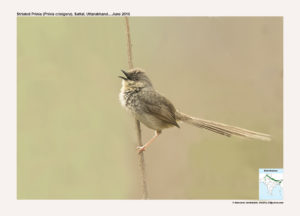Striated Prinia

Striated Prinia Prinia crinigera
Etymology :
- Prinia : Javanese name Prinyafor the Prinia
- Crinigera : latin word for long haired derived from crinis – hair ; gerere – to carry.
Vernacular Names: Kash: Phitta, Cachar: Daotishadedao, Lepcha: Dang-prim-pho, Bhutan: Shikpshillik, Nepal: Suya
Distribution in India: Resident across Himalayas
Description: Size of 15-16 cm, wt. of 14-17 g. In breeding plumage, upperparts dark dull grey-brown, streaking less clear (looking like dull mottling, rather than streaking); much of the buff on underparts is lost, but pale tips reveal extensive blackish feather bases, which form patches on breast sides, on some individuals blackish extends right across breast; tail heavily abraded, tips of longest feathers become frayed and often broken (tail appears shorter and more bleached); bill black. The non-breeding plumage has dark reddish-brown with grey tones above, crown to mantle and scapulars streaked blackish-brown, rump and uppertail-coverts un-streaked; side of head and neck buffy brown, mottled and speckled dark brown, except for paler unmarked lores and narrow eye ring; tail ash-brown, greyer on underside, outer feathers having diffuse dusky sub terminal spot and whitish tip (really evident only on shortest, outermost pair); whitish below, breast, flanks and under tail-coverts washed warm buff, breast side mottled and streaked dark brown (sometimes a few dark speckles extend across chest); iris is pale yellowish, brown or orange; bill is black during breeding, non-breeding upper mandible is brown with darker tip, lower mandible is fleshy-yellow; legs are flesh-coloured or brownish-flesh. Both the sexes are similar.The juvenile is dull brown above, with dark speckling obvious only on forehead and crown, has underparts as light buffy whitish, washed pale olive across breast; eyes is whitish. The races found in India are, Nominate (Himalayas in North India to Arunachal Pradesh ), race catharia(S & E Assam, Nagaland, Manipur), is browner and more boldly streaked than nominate, has distinctly ginger edges of flight-feathers.
Habitat: It is found in Open grassy hillsides and mountainsides with scattered shrubs, also bushy clearings in coniferous forest. Often found in rocky and grassy ravines and frequently about rank vegetation by edges of villages and terraced cultivation. In summer chiefly between 1200 m and 2300 m
Food Habits: It eats small invertebrates, chiefly insects and their larvae, and small spiders, also eats flower nectar. Usually singly or in pairs. Although not shy, is generally unobtrusive, keeping low in vegetation. It forages close to ground, climbing up stalks or inside bushes, gleaning insects from both leaves and ground.
Breeding Habits: They breed in May–Oct. The nest is constructed by both sexes. The nest is flimsy, with domed “roof” creating oval structure with entrance towards top at one side, of grass blades matted with vegetable down, interior cup lined with finer grasses; of the ground and well concealed in grassy tangle or other herbage, sometimes in thorny shrub. They lay a clutch of 3–7 eggs. The incubation is by both sexes for a period 10 and 11 days. Chicks tended by both parents. The nest is parasitized by Plaintive and common Cuckoo.